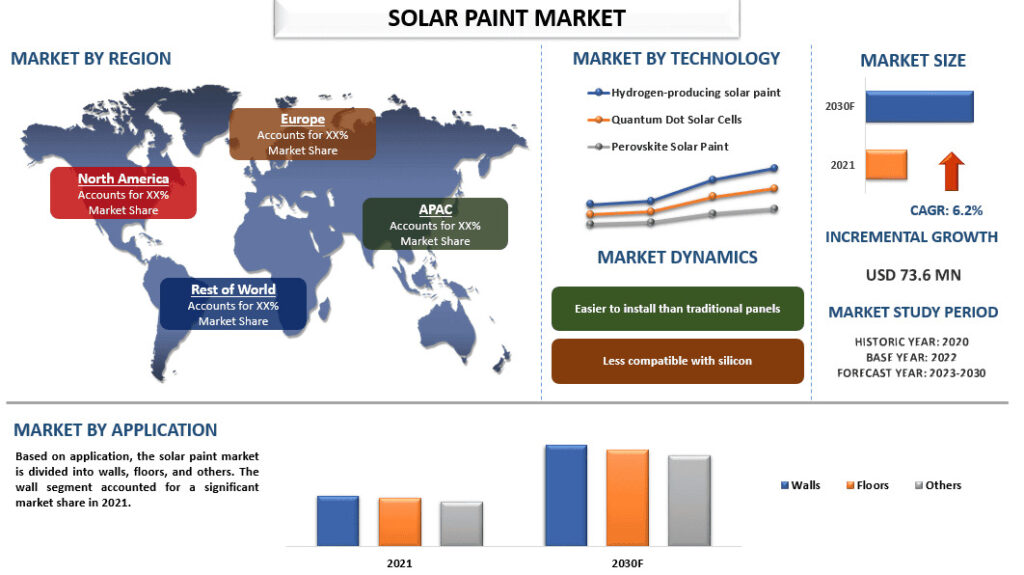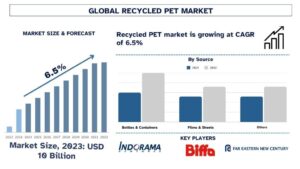
According to the UnivDatos, the rising awareness of creating energy through solar coatings with the use of photovoltaic cells will drive the global scenario in the “Solar Paint Industry” and as per their “Solar Paint Industry” report, the global industry was valued at $75.8 Mn in 2022, and is expected to reach $119.7 Mn by 2030, with global solar panel coatings industry forecast expected at a CAGR of 6.2% from 2023 to 2030.
As of 2023, the private investment amounting to tens of billions of dollars has been attracted by the Solar Industry. You know that new innovations aren’t too distant when such large amounts of money start pouring into an industry.
And what sounds more innovative than ‘solar paint’? A paint that may be generating electricity, but it’s working just like any ordinary paint? The ability to turn all of the building, not just its roof, be a solar recharging surface? If that doesn’t scream innovation, then I don’t know what does.
Access sample report (including graphs, charts, and figures): https://univdatos.com/reports/solar-paint-market?popup=report-enquiry
Until now, traditional photovoltaic energy panels have served as the main source of income for this industry. Solar panels are a proven technology that will save homeowners a lot of money. However, people often shun the switch to solar energy due to difficulties and costs associated with installation of rooftop panels.
Imagine a world where you can paint your roof and walls with the color that’s capable of generating electricity. Even though we are nowhere near being able to implement it, the thought of this technology still excites me.
So, what is solar paint? The most important thing to know is that it isn’t a single product; currently there are three different technologies that are referred to as ‘solar paint’.
The 3 types of solar paint
Solar paint hydrogen: Put simply, the paint works by absorbing moisture from the air and using solar energy to break the water molecules into hydrogen and oxygen. Hydrogen can then be used to generate energy in the cleanest way. That means that the paint is actually made up of a new substance, synthetic molybdenumsulfide. Absorbing moisture from the air, it works similarly to silica gel, which you’ve undoubtedly seen packaged with consumer products in order to keep them dry.
Quantum dot solar cells, aka Photovoltaic Paint: Quantum dots, also known as photovoltaic paint, were developed at the University of Toronto. They’re nano semiconductors capable of capturing light and converting it to electrical energy.
Perovskite solar paint: Perovskite is made from calcium titanium oxide. To create a layer of sunlight, perovskite mixture was sprayed onto the surface.
Let’s have a look on the top startups that are making great impact with their positive approach of creating the best solutions for the Solar Paint Industry.
Recent Development:
• Jan 2023: Researchers at Stanford University, developed Emerging technologies include pyramidal lenses, that concentrates the light that hits a solar cell and make solar panels more efficient in indirect light conditions.
• Jan 2023: The perovskite solar cell can be manufactured more cheaply than silicon lined panels, but at a slower rate of breakdown for use in business applications. A new perovskite device with a viable lifetime of 30 years has recently been developed by researchers at Princeton University.
• Sep 2022: Scientist of Australia’s Royal Melbourne Institute of Technology (RMIT), created a solar paint that can generate electricity.
• Dec 2022: MIT engineers have developed ultralight fabric solar cells that can quickly and easily turn any surface into a power source.
Click here to view the Report Description & TOC: https://univdatos.com/reports/solar-paint-market
Conclusion:
The solar paint industry has emerged as a promising avenue for renewable energy generation. In my blog, I discussed its potential, benefits. In conclusion, while solar paint holds immense potential for integrating solar technology into various surfaces, further research and development are needed to address efficiency, durability, and scalability issues. As advancements continue, solar paint could contribute significantly to sustainable energy solutions.
The solar paint industry holds immense promise in reshaping the way we generate and use energy. While challenges exist, ongoing research and development are gradually improving the efficiency and durability of solar paint technology. As advancements continue, we could witness a future where our built environment becomes a dynamic source of clean energy, contributing significantly to a sustainable and greener planet.
By harnessing the power of solar paint, we are taking a step closer to a world where energy generation is seamlessly integrated into our surroundings, providing a more sustainable and harmonious way of living. The journey is still ongoing, but the potential rewards are undoubtedly worth the effort.
Contact Us:
UnivDatos
Contact Number – +1 978 733 0253
Email – contact@univdatos.com
Website – www.univdatos.com
Linkedin- https://www.linkedin.com/company/univ-datos-market-insight/mycompany/




